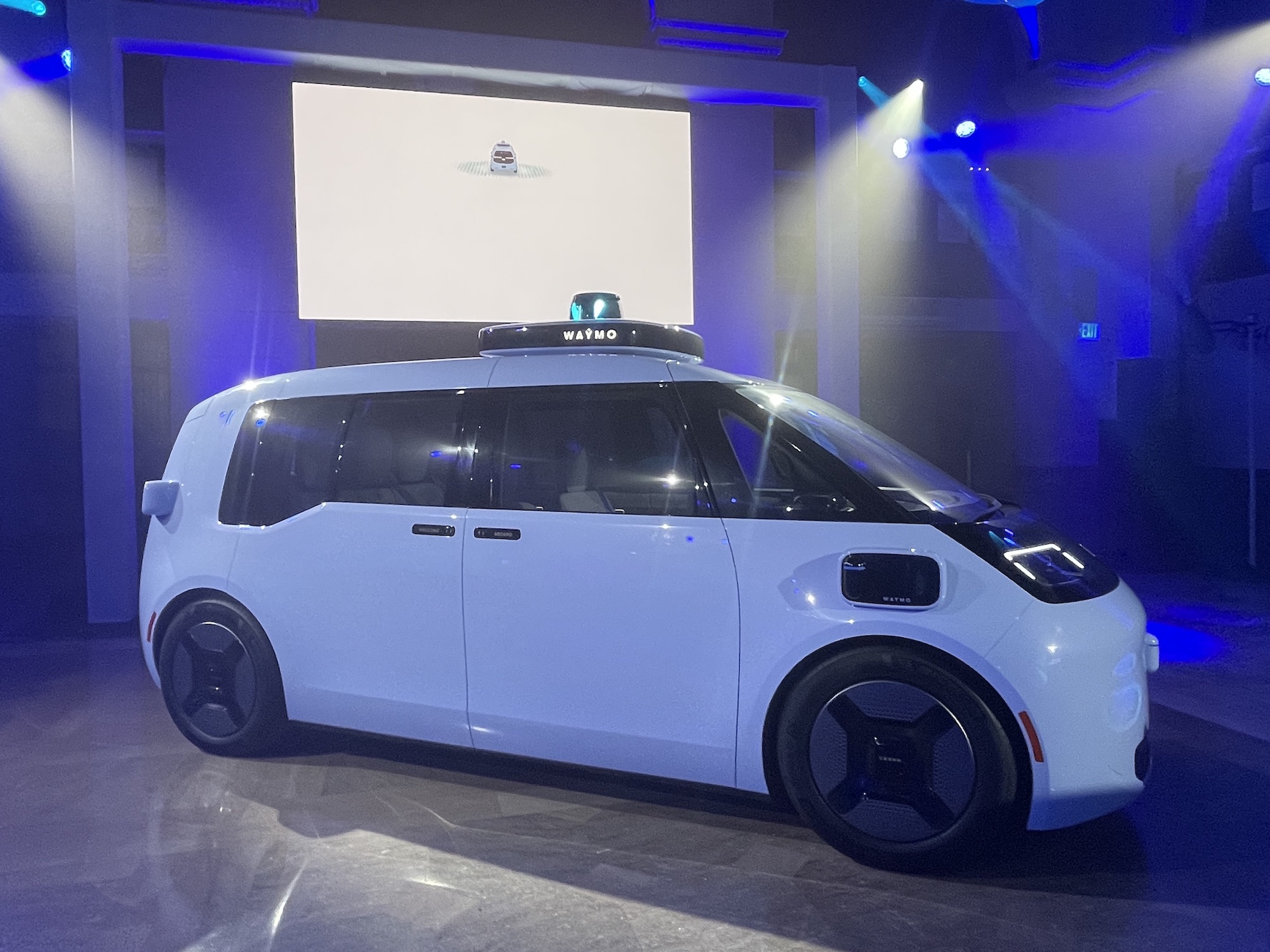The Station is a weekly newsletter dedicated to all things transportation. Sign up here — just click The Station — to receive the full edition of the newsletter every weekend in your inbox. This is a shorter version of The Station newsletter that is emailed to subscribers. Want all the deals, news roundups and commentary? Subscribe for free.
Welcome back to The Station, your central hub for all past, present and future means of moving people and packages from Point A to Point B.
It was great seeing everyone in Los Angeles, whether it was the Waymo-Zeekr event, CoMotion-related or the LA Auto Show. The LA Auto Show had more life than the previous year, but it still wasn’t the same level as those pre-COVID days.
Still, there was a bit of action on the news front — the Toyota Prius is actually good looking! — lots of execs to chat with, investors, startup founders and even design teams from other automakers (ahem, hey Rivian folks!).
On the ‘future of transportation’ front, Waymo and Geely Holding Group company Zeekr held an event in downtown Los Angeles to show its Autonomous Mobility Platform in person.
The vehicle isn’t quite a present-day minivan nor is it a sci-fi vehicle. It’s somewhere in between with some interesting details, a wisp of Swedish-inspired design thanks to partner CEVT and features meant to make it more accessible.
Here are a few details. The vehicle starts with SEA-M architecture, a refined version from Zeekr’s original Sustainable Experience Architecture (SEA) meant for “future mobility products” like robotaxis and logistics vehicles.
There are some interesting design features of the SEA-M, including the lack of a B-pillar, which might cause some to raise an eyebrow. Execs at the event assured me that the doors, when closed, provide the stiffness and security that a traditional B-pillar would. The result is a pair of doors that open at a seam and allow easy ingress and egress.
The all-electric vehicle is equipped with the self-driving system developed by Waymo, including a primary and redundant on-board compute system and loads of sensors. There’s an electric motor in the rear and a battery “capable of a full day of operation on a single charge.” Execs didn’t provide an estimate range. The vehicle is 15.1 feet in length, 5.9 feet in height, 6.5 feet in width and has a 9.8-foot wheelbase.
Inside the vehicle is a flat floor and two rows of seating — two seats in the front, where there is not a steering wheel, and one row of seats in the back. Execs at the event told me that everything is configurable and a steering wheel can be added in. That’s important if Waymo wants to launch this vehicle in the U.S., which execs said was the plan.
The seats, all of which face forward and not towards each other like the Zoox robotaxi and Cruise Origin do, are wider and lower than you might find in a traditional vehicle. The shoulder height of the seats are also lower. The seats can recline and tilt. Users may also notice braille buttons throughout the interior as well as phone charging, and adjustable AC vents. Touchscreen displays face passengers.
A bit of housekeeping: There will not be a newsletter next weekend. Enjoy your Thanksgiving if you celebrate that holiday; I’ll see y’all the following week.
Got a news tip or inside information about a topic we covered? I’d love to hear from you. You can reach at kirsten.korosec@techcrunch.com to share thoughts, criticisms, opinions or tips. Or you can drop us a note at tips@techcrunch.com. If you prefer to remain anonymous, click here to contact us, which includes SecureDrop (instructions here) and various encrypted messaging apps.
Micromobbin’
Well it’s been a pretty low week for Bird. The company told the U.S. Securities and Exchange Commission that it had been overstating revenue for the past two years, which means the company went public using partially incorrect historical data.
This came just hours before the micromobility company released its third quarter earnings report, nestled in which was a going concern warning. Bird, which is already on thin ice with the New York Stock Exchange for trading too low, said that it may not have enough funds to continue operating for the next 12 months. The company closed out the quarter with just $38.5 million in cash.
You can read a deep dive from Alex Wilhelm on how Bird clipped its own wings on TC+ (subscription).
For what it’s worth, Helbiz didn’t perform much better. The company has somehow made less revenue in Q3 2022 than it did last year. Its ride revenue took the biggest hit, despite Helbiz’s constant social media presence claiming new markets. But on the bright side for the company, revenue from its sports streaming platform is up YoY. Helbiz closed the quarter with a paltry $3.3 million in cash, but it hasn’t issued its own going concern warning just yet. The company might be crossing its fingers that its Wheels acquisition will bring in some decent revenue ASAP, even though we’re coming into the winter months which means less ridership.
New York City has decided to extend and expand the Bronx e-scooter pilot, possibly to other boroughs. The city released a Request for Proposals to find the next company(ies) to go deeper into the Bronx and beyond. Sounds like good news, but I have my concerns. For one, Lyft-owned CitiBike still has a chokehold over the city as the sole micromobility vendor in most desirable operating locations. That’s the reason the e-scooter pilot was relegated to the east Bronx. CitiBike is all over Manhattan, half of the Bronx and a good chunk of Brooklyn and Queens. If the e-scooter pilot gets extended, it will have to go where CitiBike isn’t, which is way in the outskirts — or worse, Staten Island. Great for equity and accessibility, bad for profitability.
Rad Power Bikes sent me their RadRunner 2 and RadExpand 5 to try out. The company has told me in the past that one of their target customers is people over 50 who aren’t necessarily bike riders but want to find an alternative to cars. So I put my mom on one. Read about how Rad’s bikes stack up for a millennial and a boomer.
Meanwhile Paris is considering not renewing the licenses of Lime, Dott and Tier, which expire in 2023, and instead banning e-scooters entirely. Counting on Mayor Anne Hidalgo to keep the program in some shape or form.
Voi partnered with WMG and Bumblebee Power to trial wireless e-scooter charging at the University of Warwick campus for six months. Voi scooters will be retrofitted with technology that allows them to be charged when parked over Bumblebee’s wireless charging pads
LA-based e-scooter company VoroMotors has opened a distribution center in Hawaii.
Deal of the week
Just a list of deals this week! Here’s a whole bunch of them.
Better Trucks, the logistics tech startup, raised $15 million to advance its platform that delivers next-day and two-day parcel shipping.
ECARX Holdings reached a deal with SPDB International Limited and CNCB Investment Limited for $65 million of convertible senior notes due 2025. The $65 million convertible note financing adds to the company’s $45 million in capital raised, that was announced concurrently with the merger agreement entered into on May 26, 2022 between ECARX and COVA Acquisition Corp.
EV Realty raised $28 million to develop its grid-scale charging infrastructure designed for fleet customers in key commerce hubs and along last-mile routes.
Faraday Future could receive up to a $350 million lifeline to help launch its first vehicle. The company signed a deal with an affiliate of Yorkville Advisors Global for an equity line of credit up to $350 million. The financing, which entails an initial commitment of $200 million from the New Jersey-based investment firm, will be “key” to producing the company’s long-awaited first model, the FF 91 sports car.
Lilium, the eVTOL developer, agreed to issue and sell shares to existing shareholders,new investors and strategic partners to raise $119 million. Participants include Honeywell and Aciturri as well as LGT and its affiliated impact investor Lightrock, Tencent, B. Riley Securities and certain affiliates thereof. Lilium’s new CEO, Klaus Roewe, as well as three additional board members, Barry Engle, David Wallerstein and Niklas Zennström, also participated.
Parallel Domain, a startup that has built a data-generation platform for autonomy companies, raised $30 million in a Series B led by March Capital, with participation from return investors Costanoa Ventures, Foundry Group, Calibrate Ventures and Ubiquity Ventures.
Revel got an additional $50 million in debt from BlackRock that it will use to grow its network of EV fast charging hubs, with an eye towards building more in NYC.
Swoop Aero was also recently awarded $1.5 million in USAID Development Innovation Venture Funding. The funding will be used to help the drone logistics scale into new areas.
Notable reads and other tidbits
Autonomous vehicles
Cruise expanded its driverless ride-hailing service in San Francisco to daytime hours. Its just for employees right now and will open up to the public at a later date.
Motional and Lyft say their second robotaxi market will be Los Angeles. Although when that will happen is hard to say since Motional still only has a drivered testing permit with the California DMV. The AV company will need to score a driverless testing permit and then a deployment permit before it can start carrying passengers for free. Being able to charge them is a whole other kettle of fish.
Nuro, the autonomous vehicle delivery startup backed by SoftBank, Google and Tiger Global Management, is laying off about 300 people, or 20% of its workforce. Nuro co-founders Dave Ferguson and Jiajun Zhu sent employees an email detailing their decision. Tl;dr: during the fundraising frenzy in 2021 they doubled down on hiring. With economic headwinds the company is forced to scale back.
Waabi unveiled its first generation of self-driving trucks that are purpose-built for OEM integration. The trucks are powered by the Waabi Driver, a combination of Waabi’s software, sensors and compute.
Waymo detailed in a recent blog how the company uses data collected from its vehicle sensors and high quality ground-truth data from weather visibility sensors to turn each Waymo vehicle into a “mobile weather station.”
Speaking of Waymo, the company has finally received the driverless pilot permit from the California Public Utilities Commission. That means Waymo can now bring the rider-only experience to San Francisco residents. No human safety operator required.
Zoox had a crash in Las Vegas. A 2016 Toyota Highlander outfitted with fully autonomous driving technology and operated by Zoox rear-ended a tractor-trailer owned by Las Vegas Paving, the Las Vegas Review Journal reported. It seems that the human safety driver, who was driving it manually at the time, still expected the vehicle to stop on its own.
Electric vehicles, batteries & charging
Archer Aviation unveiled its production eVTOL aircraft, Midnight. The company is working to certify Midnight with the Federal Aviation Administration in late 2024 and then use it to help launch its urban air mobility network in 2025.
General Motors’ e-delivery van subsidiary BrightDrop said it’s on track to reach $1 billion in revenue next year. The company also said at an investor conference that supply chain constraints won’t hinder its goal of reaching electric vehicle profitability by 2025.
Redwood Materials will supply Panasonic Energy of North America with cathode material for battery cells produced at a new factory currently under construction in Kansas. The new $4 billion Panasonic factory, which will be larger than the Tesla Gigafactory in Sparks, Nevada, is expected to begin mass production of its “2170” cylindrical lithium-ion batteries by March 2025. The deal is worth several billion dollars.
In-car tech and ADAS
Tesla reported two new fatal crashes that are tied to advanced driver assistance systems.
Ride-hailing, car-sharing etc.
Finn is bringing its car subscription platform to New York and Rhode Island.
Lyft partnered with SpotHero to help customers and drivers find and reserve a parking spot through the Lyft app.
Uber and Lyft will have to increase the minimum pay rates for drivers in New York City by the end of the year. The fare increase comes amid a driver shortage post-pandemic, in large part due to rising operational costs.
LA Auto Show recap
A few more bits of coverage are still coming, but here is some of what we saw.
► Toyota unveils all-electric SUV concept under ‘beyond zero’ badge
► The new 2023 Toyota Prius plays up power, not fuel economy
► Genesis teases its EV future with the Genesis X convertible
► Stellantis is bringing the all-electric Fiat 500e to North American in early 2024
► Fiat CEO teases car subscriptions, car-sharing for all-electric 500e launch in U.S.
► Hyundai launches home charging ecosystem
► Hyundai’s hydrogen fuel cell concept hints at N performance brand ‘s future
► Vinfast bid to attract US buyers includes 4 electric SUVs and maybe even a sports car
► Everything we know about the 2023 Hyundai Ioniq 6
And finally, Lucid had an event in Beverly Hills to hand over the first of its Air Touring model. The company also teased the all-electric SUV, called the Gravity, and said reservations are opening in early 2023. A little insider tip: the model lineup that Lucid carved out for the Air sedan will be represented in the Gravity range as well, which would include a Sapphire version, possibly multiple versions of it.
People
Skyryse appointed former Delta Airlines pilot Bill Warlick as head of Flight Test Operations to oversee the planning, coordinating, and monitoring of the company’s aircraft and flight test operations as the company brings its technology, FlightOS, to market.
Inside the Waymo-Zeekr robotaxi, Bird spirals and layoffs come to Nuro by Kirsten Korosec originally published on TechCrunch
DUOS










